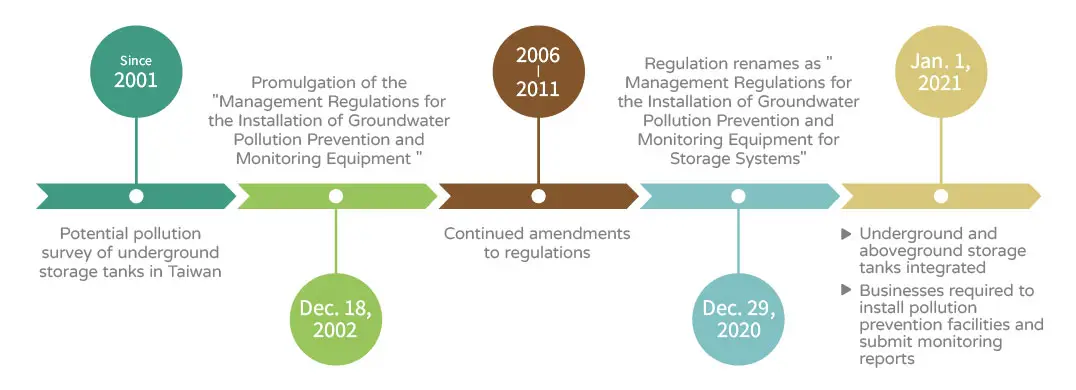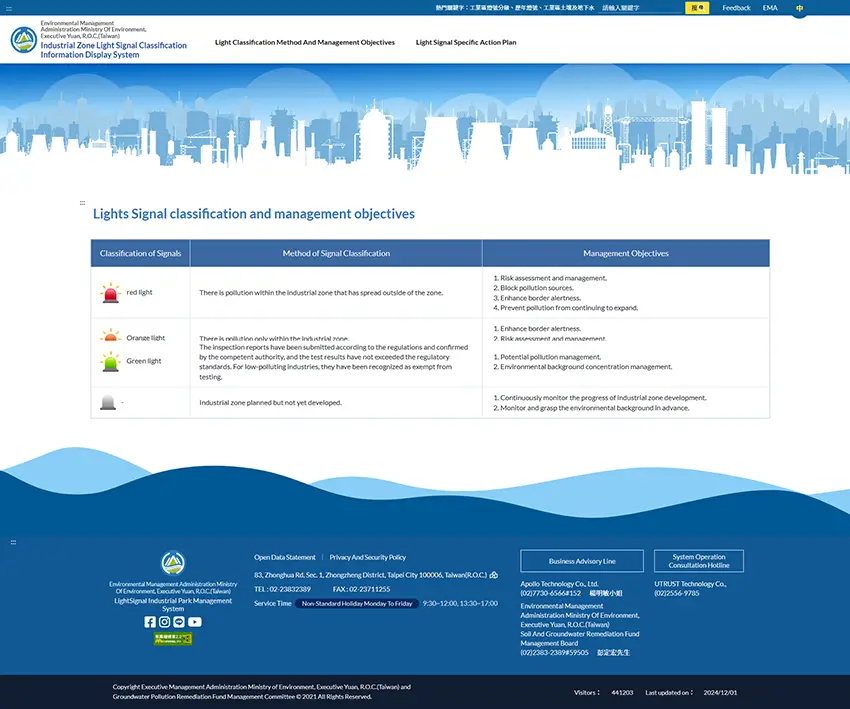 Enterprise Pollution Prevention
Enterprise Pollution Prevention
With the promotion of environmental protection and sustainable development, the government is actively committed to the prevention and management of soil and groundwater pollution. The following sections outline the government's initiatives and achievements across different areas, including gas stations storage tanks, factories, and industrial zones.
Gas Station Storage Tank Pollution PreventionTo enhance the management and guidance of underground storage tank systems and to urge businesses to implement pollution prevention measures, the Environmental Protection Administration (now the Ministry of Environment) established the "Management Regulations for the Installation of Groundwater Pollution Prevention and Monitoring Equipment" on Dec. 18, 2002, which was subsequently amended twice, on July 4, 2006, and Jan. 14, 2011, with the title changed in 2011 to the "Management Regulations for the Installation of Groundwater Pollution Prevention and Monitoring Equipment for Underground Storage Tank Systems." Moreover, due to recent soil and groundwater pollution incidents involving above-ground storage tanks, further amendments were made to the "Management Regulations for the Installation of Groundwater Pollution Prevention and Monitoring Equipment for Underground Storage Tank Systems" on Dec. 29, 2020, updating the title to the "Management Regulations for the Installation of Groundwater Pollution Prevention and Monitoring Equipment for Storage Systems" (hereinafter referred to as the "Storage System Regulations"). The regulations came into effect on Jan. 1, 2021, consolidating the management of both underground and above-ground storage tank systems, mandating that businesses must properly install groundwater pollution prevention and monitoring equipment, as well as monitor and make reports to prevent environmental pollution incidents.
Since 2001, survey and reporting projects have been conducted, completing a comprehensive assessment of the pollution potential of underground storage tank systems across Taiwan. Compliance with groundwater pollution prevention facilities regulations has been verified, and efforts continue through cross-referencing data from businesses' monitoring reports. Abnormalities in monitoring reports are checked, and soil and groundwater verification work are conducted for high-risk areas to prevent and monitor pollution.

To strengthen businesses' management and guidance of soil and groundwater, ensuring their pollution prevention practices, and preventing soil and groundwater pollution from factories that affect public health and environmental quality, the Environmental Protection Administration (now the Ministry of Environment) began conducting specialized investigations into the soil and groundwater pollution potential of various types of factories in 2004. From 2004 to 2020, nine phases of investigations were completed to assess pollution potential on land at abandoned factories. From 2008 to 2014, five phases of "Operational Factory Soil and Groundwater Chlorinated Organic Solvent Pollution Potential Investigation and Verification Project" (referred to as the "Chlorinated Solvent Project") were implemented, tracking factory type, site characteristics, and land quality to prevent the spread of soil and groundwater pollution. From 2014 to 2022, the Ministry of Environment expanded these efforts through a four-phase "Operational High-Pollution Potential Factory Soil and Groundwater Pollution Potential Investigation Demonstration Project" (referred to as the "High-Pollution Potential Factory Survey Project"), identifying factories with high pollution potential and conducting expanded investigations. This project analyzed the characteristics of operational factories nationwide by industry and production processes to develop high groundwater pollution potential prevention and management strategies, aiming to use field inspection and investigation experience to support proactive pollution prevention management among high-pollution potential factories. Since 2023, the Ministry of Environment has adopted a prevention-centered approach to pollution management, promoting autonomous soil and groundwater pollution prevention within businesses. This involves a categorized and tiered management strategy based on factors of pollution potential such as industry type, pollution sources, and operational characteristics. Businesses are categorized into three groups: "A. Enhanced Management Group", "B. Self-Management Group" , and "C. Review Management Group" . A group list is established annually to conduct field inspections, investigations, and prevention management for high-potential soil and groundwater pollution businesses to ensure comprehensive oversight.
Since 2010, the Ministry of Environment has amended relevant regulations, requiring competent authorities of industrial zones to regularly monitor soil and groundwater quality and submit the data for record-keeping. A nationwide update of industrial zone data has been completed, with soil and groundwater monitoring management information presented on maps and categorized into a four-level indicator system. Each level has specific management objectives and action plans. The Industrial Zone Light Signal Classification Information Display System has been built, and indicator management metrics are published regularly to enforce pollution control and preventive management in industrial zones.

Although awareness of soil and groundwater protection started later in Taiwan, businesses remain hesitant or cautious in committing to environmental protection ideas such as pollution prevention, and law enforcement and investigation techniques are still improving. However, there is now a consensus and public demand for a high-quality environment and sustainable resource, which is gradually becoming the mainstream for civic awareness and resource policies.
It is recommended that comprehensive investigation and management of businesses with soil and groundwater pollution potential be prioritized to facilitate early pollution detection and containment, thereby helping to preserve the quality of business lands and groundwater and ensuring the sustainable use of soil and groundwater resources.
- Data Source: Soil and Groundwater Pollution Remediation Fund Management Board
- Publish Date: 2024-11-28
- Update Date: 2025-12-18

 Related Topics
Related Topics

